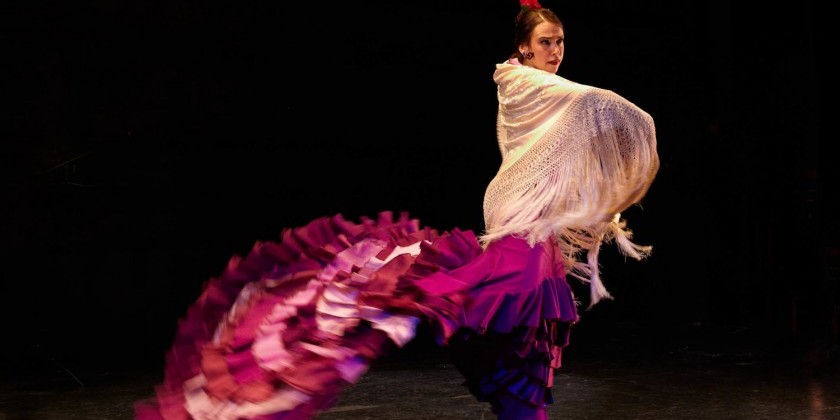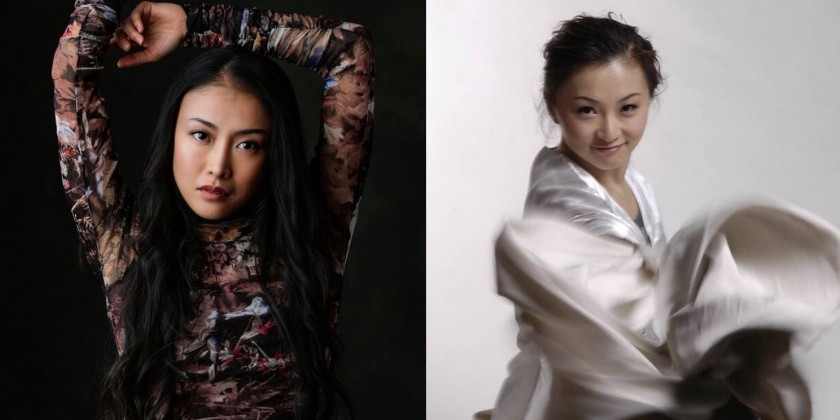The Dance Enthusiast Asks: Sally Sommer, Executive Producer of “Check Your Body At The Door”
Co-Producers: Archie Burnett and Barbara Tsumagari
Directors: Charles Atlas (1995-1999) and Michael Schwartz (1992-1993)
Featured dancers: Archie Burnett, Brahms “Brava” LaFortune, the late Willi Ninja, Brian “Footwork” Green, Marjory Smarth, Ejoe Wilson, Barbara Tucker, Conrad “SP” Rochester, Asia Moon, Iriena Herrera, Willy Pinedo, Courtney “French” Ffrench, Carlos Sanchez, Kris Buxenbaum, William “Quick” Reynolds, Ronald “Ricochet” Thomas, Adrian Alicea, and Omar Kashim Henry
Supported by the National Endowment for the Arts
Sponsored by the New York Foundation for the Arts (NYFA)

Barbara Tucker. Photo: Andrew Eccles.
Delve into an alternative realm where dance and music coalesce, attracting free, footloose spirits. Sally R. Sommer’s documentary "Check Your Body At The Door" provides rare footage of the underground House scene of the 1990s and intimate interviews with pioneer House dancers. Like New York City, its place of origin, House dance is a melting pot containing elements of Salsa, African circle dancing, Funk, and more.
To ‘check your body at the door’ means to leave all baggage at the door and to enjoy one’s self to the fullest. Underground clubs were a safe haven where ‘Clubheads,’ as the dancers proudly called themselves, could escape after working 9-5 jobs.
The documentary explains the differences between House dancing and Hip-Hop, shatters negative media portrayals of underground clubs, and clarifies how these sanctuaries provided more than a place to dance; for many dancers, underground clubs were a means to get off the streets, break cultural reins, and explore artistry via movement.
The film’s colorful subjects range from Co-producer Archie Burnett, who wore out his mother’s rug with his dancing, to the late Willi Ninja who also appeared in "Paris is Burning."
Hit the play button and be prepared to be mesmerized by hypnotic hand and head spins. Follow the ‘Clubheads’ and find out why House is also called freedom dancing.
Watch "Check Your Body at the Door"
The Check Your Body at the Door producers are pleased to announce a partnership with digital distributor TenduTV and the release of the film on iTunes. CYBATD is now available for purchase ($9.99) and rental ($3.99), and is available in six languages in over 20 countries (international prices vary). The global release of Check Your Body at the Door is a culmination of nearly 20 years of work on the film.
An Interview with Sally R. Sommer, Executive Producer of ‘Check Your Body At The Door’ and Professor at The School of Dance at Florida State University:
Sammi Lim for The Dance Enthusiast: Any project spanning 30-years is definitely a labor of love. When you first decided to produce "Check Your Body At The Door," did you estimate its long-running duration? While many might have lapsed into boredom, how did you stay self-motivated?
Sally R. Sommer: I began thinking we’d knock this film out in two or three years. Naïvely, we did not gather 85% of the money before starting to shoot. This put us in the position of jumping from one little clump of money to the next, going on hiatus in between, as I raced to submit the next round of grants. This “labor of love” went on for 19 years.
The National Endowment for the Arts (NEA), and (NIPAD), National Initiative to Preserve America’s Dance, a project of the Pew Charitable Trust, generously supported the project -- however any grant needs about two years between the writing, submission, review, approval and ultimate receipt of funds. And no project will get funded year after year. Had I been making a documentary about the poor beggar outside the club (socially PC) I could have been fully-funded. But a film about clubs? And club dancing? Never! Not politically correct.
Production crews came and went. But the dancers remained stable and “there.” The ‘Check Your Body’ group had births, deaths and MIAs, but the dancers remained true and loyal; we had forged a family based on respect and love of good dancing. Simple and straightforward.
I got physically tired, but never bored. These people are endlessly fascinating to me as friends and movers. They are my chosen family.

TDE: "Check Your Body At The Door" has been hailed as a historically significant documentation of New York City's House dancing in the 1990s. Research took you to myriad underground clubs that may or may no longer exist today. What were your first impressions of House dancing and these clandestine environments?
Sommer: I was always an avid social dancer, always an “undergrounder.” I dislike mainstream chic clubs and the scene, scoping and being scoped, and what really bores me - people standing, doping and drinking -- not dancing.
My first big research (and articles) of NYC underground clubs began in the mid-1970s. I was a dance critic for Village Voice and when I got restless with choreographed work, I slipped over to club world. Whether roller-skate dancing, nascent hip-hop or slam dancing, social dancing is always surprising because so many people create it. The Underground offers freedoms rarely seen “above ground.”
But nothing prepared me for the sheer invention and raw joy of the dancing and music in the basement (talk about underground!) of David Mancuso’s “The Loft” in 1982-3. Black walls, colorful balloons on the ceiling and walls, deep House beats thumping the sternum, hard-dancing bodies on different floors, each with different styles of dancing and music, different age groups. Unlike the Garage, the Loft was mixed (gay and straight, men and women, diverse racially in age). Great stylists gathered together to exchange moves, to make up new moves, propelled by the pleasure principle and tacit competitions that never got nasty. The prevailing code of behavior was fun, civility and safety and, instead of exclusivity, inclusivity.

TDE: How did you meet Archie Burnett, who not only stars as the central narrator, but also co-produced the film? What about Archie so inspired you to make him your muse?
Sommer: I was a professor at The School of Visual Arts in the late ‘70s and early ‘80s. Archie was my student in 1982. He signed up for my class - something about the history and evolution of ‘Popular Black Dance Styles in the 20th Century.’ Archie figured he already knew it and the class would be easy. When he saw the white female professor, his skepticism soared. About 80% of the class was Black or Latino so I had to address the unasked question: “You want to know why a white woman is teaching you about your own dance history and styles?” Silent gasp. “Because I like good dancing and as a trained dance historian, I study the dancing I like.” Of course they wanted to know if I went to the clubs and I said “yes.” A couple weeks later, Archie asked me which clubs I went to. I named a couple and he said, “Oh, you gotta come to the Loft.” So I met him there.
Why Archie? Why is he my muse? I have known him for 30 years. He is a great dancer with a distinct style (which has now gone worldwide); his lines and shapes are clean and he has a wide dynamic range and innate choreographic excellence. As a man, Archie has a personal elegance based on integrity and graciousness. We laugh a lot, neither of us has many pretentions. Archie never disses anyone; he encourages and is beloved for that generosity.

TDE: One reason dance nuts should watch this documentary is because it affords them rare glimpses of the lives of House dancers. I was thrilled by select scenes shot at artists' day jobs and homes, especially one segment where the late Willi Ninja enjoys Kung fu movies in his living room; not only does this portray his 'humanoid' side (for he was quite an intimidating and incredibly beautiful creature. R.I.P.), but it reveals his inspiration for dance - how he absorbs martial arts hand movements and translates them to dance.
How did you get your subjects to open up and welcome cameramen to enter their private spaces?
Sommer: Willi and I were already good friends before we shot that scene. I knew his mom so bringing the film crew to his house was fun. He often came to my apartment. He loved my daughter and my Italian niece. They lent him clothes and he took them out. Beautiful. Willi was keenly observant and open-minded. He was a great mimic and incredibly funny. What shines through in the film is his generosity in crediting Kung Fu, his neighborhood, his love of his mother, and his commitment to the House of Ninja for shaping him and his dancing. He was deeply interested in all kinds of dance and dancers, and watched all kinds of dancing on TV. He was able to cross-platform, to make smart connections. Willi‘s brilliance and charm opened the closed fashion business and re-instated voguing on the runway. What an accomplishment! God, how I miss him.
How I got subjects to open up to me: As Archie and Bravo say, I put in time at the clubs starting from the ‘80s. I was always there. By the way, I always went alone. Trust subsequently evolved from being present. I put dancers front and center; their craft came first, personally and professionally. Consequently our relationships were based on something they were good at, eschewing messy personal complications. We held each other to something higher than “personality” or looks. This foundation enabled them to give the best sides of themselves to the camera and me. Trust spread and they felt safe telling me about their inner lives and values on camera in poignant and informative interviews. Respect is the key.

TDE: Where does House dancing stand today? Does it remain exclusive from the emergence of contemporary dance and electronic styles or is it becoming part of the same dance vocabulary?
Sommer: More than 25,000 clubs in the greater New York and New Jersey areas during the 70s-early 80s is now roughly 230 clubs. This has horribly diminished House dancing. When we made the film, I thought we were making a eulogy to a dance form that was dying and would not be seen again. Then, wham! In early 2000, interest in House dancing and music exploded in Europe, Asia and South America. They have taken the form and developed it – while it is a dead dog in the USA. But the techniques and ideology were spread abroad by many of the great dancers in ‘Check Your Body…’
This social dance translocation is typical of popular dance forms, which in the 20th century, began in black communities, and then spread to the mainstream and out to the world as major dance fads. American social-dance invention never stands still; it keeps moving forward, and in the process, loses interest in the old styles because it is busy forging ahead into new forms.
The place where House is alive in America is the concert-dance world, specifically chic contemporary forms. Somewhat into ballet as well! The parallels are obvious and stage forms always seek renewal in social dance forms. I get very irritated when House dance is equated with Voguing and ‘gayness.’ That is reductive history mongering and revisionist stupidity that undercuts what House dancing was about and what it is in the international scene. I think it’s a popular stance because it allows writers and historians to easily hook into gender and queer theories. That is only a slice of the broad scope of what made up House dancing.
Follow Sammi Lim on Instagram and Twitter @ilikeloofahs













